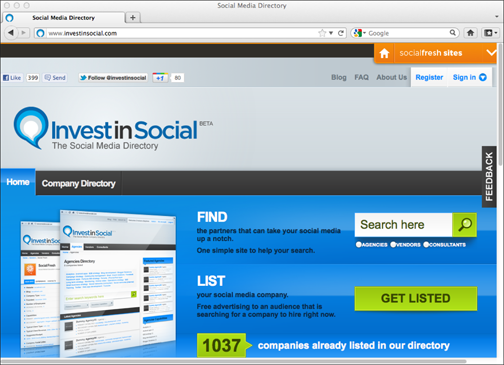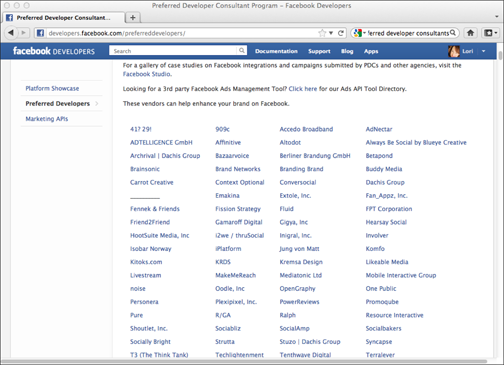Figure 3-1: Investin social.com.
Creating an Easy-to-Follow System for Your Team
I’m a huge fan of the KISS principle (Keep it Simply Sensational). As you read through in order to decide how you want to organize your regular team, please think in terms of efficiency. In this section, I show you how to pull together a system that will help you use social networking to build a stronger and more resilient brand online.
Much of online reputation management can be done simply and without using up all your time and resources. After all, you have a business to run, don’t you? And you can save even more time by focusing your attention to listening and responding online for brief periods of time, scheduled periodically throughout the day.
Multitasking works just about as well in online reputation management as it does in the rest of life. If you’re part of a small team and need to check in to your social accounts a few times a day, I suggest you invest in an ordinary kitchen timer (or a kitschy one like the one I use) and set it for 15 minutes at a time. This way you monitor, ask juicy questions or make dazzling statements, share useful posts, respond to people, and then get back to work. Frequency of interaction is more important than duration of your stay on that network.
Committing to your objectives
Here’s where the Chapter 2 goals I admonish you to define come in. The main goals make great objectives for your team. Write down your top three goals as clearly as possible and post them so that the people you report to and the people you’re leading can understand at a glance what the ultimate goals are.
Everybody working with you will enjoy having such easy-to-understand direction. It saves you an enormous amount of time and energy as you move forward and will be a huge asset if a crisis should arise. Your team members should function like a well-trained soccer team, with each member playing her role and knowing how to work together effectively.
In Chapter 9, I show you how to use these objectives to effectively communicate your brand online. Having a well-designed online reputation management system is one of the most powerful things you can do to build your business!
Choosing what kind of team members you want
Now that you have your goals set in order of importance, it’s time to recruit the right kind of team to deliver on them.
I list all the different social media team animals in the zoo so that you can have an idea of what they do, though job descriptions and responsibilities vary wildly. My best advice is to evaluate people closely and to get concrete examples of the kind of work that they do on a routine basis.
I suggest you begin by recruiting people who are experienced with social media monitoring tools and who can
![]() Accurately interpret reports
Accurately interpret reports
![]() Discern trends
Discern trends
![]() Communicate how to use momentum from trends to further your goal
Communicate how to use momentum from trends to further your goal
![]() Enjoy keeping up with the latest monitoring tools and techniques
Enjoy keeping up with the latest monitoring tools and techniques
![]() Always keep an eye out for return on investment (ROI) with social media activity
Always keep an eye out for return on investment (ROI) with social media activity
![]() Effectively create and communicate strategy
Effectively create and communicate strategy
![]() Exude enthusiasm about your brand
Exude enthusiasm about your brand
There seem to be as many job descriptions for social media roles as there are Twitter accounts, but if you just focus on covering these skill sets, you’ll do well, no matter what sorts of positions you decide to create in recruiting your team. A rose by any other name is still a rose! These are your most crucial roles.
Who should not be on your team?
Online reputation management is a new area for most organizations, and most people have a few misconceptions about the skill sets involved. Don’t draft the following types of people just because it may seem like the logical thing to do. It may not be logical at all!
![]() Somebody from the IT department, based on the fact that he probably won’t be intimidated by learning the tools. You need somebody with a passion to socially share your brand and further your particular goals.
Somebody from the IT department, based on the fact that he probably won’t be intimidated by learning the tools. You need somebody with a passion to socially share your brand and further your particular goals.
![]() A junior executive, based on the perception that she’s young and “with it,” so she ought to be able to take this on as well as anybody else. You need somebody who truly understands how to build and influence community online, which just isn’t taught in traditional MBA programs.
A junior executive, based on the perception that she’s young and “with it,” so she ought to be able to take this on as well as anybody else. You need somebody who truly understands how to build and influence community online, which just isn’t taught in traditional MBA programs.
![]() A self-proclaimed “social media guru” with no testimonials. Being online a lot doesn’t translate into understanding marketing principles or being able to evangelize your particular brand.
A self-proclaimed “social media guru” with no testimonials. Being online a lot doesn’t translate into understanding marketing principles or being able to evangelize your particular brand.
Deciding who runs your team
It’s crucial to hire inspiring, effective, social media team leaders. Ideally, they are
![]() Diplomatic people with strong “people skills”
Diplomatic people with strong “people skills”
![]() People who can recognize trends through data and analytics
People who can recognize trends through data and analytics
![]() People who are terrific at saying a lot with a few words
People who are terrific at saying a lot with a few words
![]() People who are genuinely enthusiastic about your brand
People who are genuinely enthusiastic about your brand
![]() People who are able to spot the right kinds of content to share from fans and competitors
People who are able to spot the right kinds of content to share from fans and competitors
![]() People who understand your particular online social ecosystem
People who understand your particular online social ecosystem
![]() People who are sensitive to other people’s race, sexual orientation, and religion
People who are sensitive to other people’s race, sexual orientation, and religion
![]() People who keep quiet about their political views
People who keep quiet about their political views
![]() People who are empathetic to the feelings of people online who are sincerely reaching out to the brand for either customer service or information
People who are empathetic to the feelings of people online who are sincerely reaching out to the brand for either customer service or information
![]() People who stay levelheaded under pressure
People who stay levelheaded under pressure
![]() People who write well
People who write well
![]() People who are able to consistently inspire others online to take action
People who are able to consistently inspire others online to take action
As you pull together your social media team, it’s probably a good idea to name it something that other people can recognize quickly. Since this is still a very new area, I’m sharing the following list of possibilities for your consideration. Respondents in the Forrester Consulting survey of 200 U.S.-based companies named these as their top-five departments:
![]() Social Media/Web 2.0 Team
Social Media/Web 2.0 Team
![]() Marketing and/or Public Relations
Marketing and/or Public Relations
![]() Web-Interactive Marketing
Web-Interactive Marketing
![]() Product Marketing
Product Marketing
![]() Marketing Operations
Marketing Operations
Authorizing your employees to engage during a crisis
I go into this topic in greater detail in Chapters 14 and 15, but right now it’s important to contemplate the pros and cons of allowing your employees to engage during a crisis. Some considerations include
![]() Your typical employees: If your organization overflows with outgoing, levelheaded people who enjoy social networking, this may be a really good idea, after they have been apprised of your social media policy for employees and the crisis communications message of the moment. It’s essential for everyone to be on the same proverbial page so that your message can go out as smoothly as possible.
Your typical employees: If your organization overflows with outgoing, levelheaded people who enjoy social networking, this may be a really good idea, after they have been apprised of your social media policy for employees and the crisis communications message of the moment. It’s essential for everyone to be on the same proverbial page so that your message can go out as smoothly as possible.
![]() Your inter-departmental communication: If your organization can communicate quickly and effectively throughout departments, authorizing employees to engage during a crisis may be a great relief.
Your inter-departmental communication: If your organization can communicate quickly and effectively throughout departments, authorizing employees to engage during a crisis may be a great relief.
![]() The nature of the situation: You need to protect your employees if an issue turns ugly by not asking them to involve their personal profiles and social accounts. Use your best judgment and err on the side of caution.
The nature of the situation: You need to protect your employees if an issue turns ugly by not asking them to involve their personal profiles and social accounts. Use your best judgment and err on the side of caution.
Identifying brand ambassadors
It’s always great to have friends when you are experiencing pressure online. Your best friends can be people who already know and love your brand who will stick up for you to their audiences. These kinds of people are often called brand ambassadors. (I cover this in greater detail in Chapters 14 and 15.) For now, consider cultivating relationships with your brand ambassadors by researching the following:
![]() Who are your most passionate fans online?
Who are your most passionate fans online?
![]() How large are their audiences?
How large are their audiences?
Ask your team to use research the answers to these questions. When you’ve found your ambassadors, brainstorm ways to deepen your relationships with them.
Outsourcing your team
Sometimes it’s more convenient and cost-effective to hire someone outside your organization to perform a specific function. This section explains some of the best choices available.
Using virtual assistants (VAs)
Virtual assistants are people who work remotely and can communicate with e-mail, phone, Skype, or instant messaging (IM). Hiring VAs has lots of perks, such as
![]() They save you time by creating reports, creating templates for repetitive tasks, and performing general assistant work.
They save you time by creating reports, creating templates for repetitive tasks, and performing general assistant work.
![]() You don’t have to provide office space or supplies for them.
You don’t have to provide office space or supplies for them.
![]() They’re paid as a vendor, so you can write the expense off on your organization’s taxes.
They’re paid as a vendor, so you can write the expense off on your organization’s taxes.
![]() They can organize your team’s schedule/efforts for you.
They can organize your team’s schedule/efforts for you.
![]() Many can serve as a simple site administrator and keep your organization’s blog up to date.
Many can serve as a simple site administrator and keep your organization’s blog up to date.
The best way for you to find a qualified, reputable VA is via personal recommendations from trusted colleagues based on the assistant’s stellar qualifications and record. Second to this, you can find terrific ones online here:
![]() Twitter: Just tweet out your desire for referrals from personal connections and you will start to hear back soon.
Twitter: Just tweet out your desire for referrals from personal connections and you will start to hear back soon.
![]() Craigslist: This may be a viable option if you want to meet someone face-to-face before deciding if he’s the right VA for you. Discover your local Craigslist at
Craigslist: This may be a viable option if you want to meet someone face-to-face before deciding if he’s the right VA for you. Discover your local Craigslist at www.craigslist.org/about/sites
.
![]() VA networking: Find them where they live online! This is where VAs collaborate on the most efficient ways to do things. Come to think of it, I need to browse there to pick up on a few ideas myself! You should consider doing the same. Here are a couple informative sites where you can submit a request for proposal from a virtual assistant and learn more
VA networking: Find them where they live online! This is where VAs collaborate on the most efficient ways to do things. Come to think of it, I need to browse there to pick up on a few ideas myself! You should consider doing the same. Here are a couple informative sites where you can submit a request for proposal from a virtual assistant and learn more
• International Virtual Assistants Association (www.ivaa.org
)
• Virtual Assistant Networking Association (www.vanetworking.com/clients
)
![]() Resource Nation: Streamlines the process for you by matching you with pre-screened, qualified VAs. It provides this as a complimentary service. You can find it at
Resource Nation: Streamlines the process for you by matching you with pre-screened, qualified VAs. It provides this as a complimentary service. You can find it at www.resourcenation.com
.
![]() Tasks EveryDay: This site, which has been featured on CNN and the New York Post’s website, is based on a monthly fee but is truly spectacular if you want 24-hour live access to a VA. It even provides local phone numbers for the people you’re working with. This is one example of how life can really be a lot easier in this new, worldwide economy. Check it out at
Tasks EveryDay: This site, which has been featured on CNN and the New York Post’s website, is based on a monthly fee but is truly spectacular if you want 24-hour live access to a VA. It even provides local phone numbers for the people you’re working with. This is one example of how life can really be a lot easier in this new, worldwide economy. Check it out at www.taskseveryday.com
.
![]() AssistU: May be more cost-effective because this site is where many VAs start their training. Learn more at
AssistU: May be more cost-effective because this site is where many VAs start their training. Learn more at www.assistu.com
.
Hiring a social media (or “digital”) agency
Many people believe that social media teams belong under the direct supervision and direction of a marketing department or firm. Some people think that public relations firms should hold the key to your social media team’s leadership. Either way, there are lots of benefits to hiring out because it can save you the time, effort, and resources involved in hiring, training, and supervising new recruits.
The downside is that many of these agencies have sprung up overnight. Just because they have awesome graphics and bold copywriters on their blogs doesn’t mean that they necessarily have the savvy and strength to contribute to your brand’s goals in a meaningful way. Beware of baloney!
Here are the best ways to find a social media marketing agency or public relations firm for your online reputation management needs:
![]() Seek personal recommendations from a trusted friend who thinks the agency is great based on actual results
Seek personal recommendations from a trusted friend who thinks the agency is great based on actual results
![]() Use a qualified social media directory, such as
Use a qualified social media directory, such as
• Investinsocial.com’s Social Media Directory (see Figure 3-1)
• Facebook’s list of Preferred Developer Consultants (see Figure 3-2)
• Word of Mouth Marketing Association’s Buyers Guide (see Figure 3-3)
Once you find a potentially good candidate, always research the firm by
![]() Following up on brands it claims it helped to promote
Following up on brands it claims it helped to promote
![]() Following up on at least three references
Following up on at least three references
Beware of providers who use sketchy qualifiers like these:
![]() Acting like a know-it-all: No one knows it all. It’s usually a smoke screen intended to cover one obvious limitation or another.
Acting like a know-it-all: No one knows it all. It’s usually a smoke screen intended to cover one obvious limitation or another.
![]() Saying they will completely manage your social media presence online: How can an uninformed third party possibly communicate details about what’s going on with your organization? You definitely will need to be involved, but you don’t have to read every tweet.
Saying they will completely manage your social media presence online: How can an uninformed third party possibly communicate details about what’s going on with your organization? You definitely will need to be involved, but you don’t have to read every tweet.
![]() Saying that they have a large, experienced team: Anybody can say that. Get specific information about the people who will be working on your campaign and follow up on it. You may be surprised to learn that they’re just sorority girls back from spring break working on their internship until a real, paying job comes along.
Saying that they have a large, experienced team: Anybody can say that. Get specific information about the people who will be working on your campaign and follow up on it. You may be surprised to learn that they’re just sorority girls back from spring break working on their internship until a real, paying job comes along.

Figure 3-2: Facebook’s list of Preferred Developer Consultants.

Figure 3-3: Word of Mouth Marketing Association’s Buyers Guide.

Creating an easy-to-follow framework
Putting together your team is a great investment that will pay off via a healthy reputation online, especially when you create an easy-to-follow framework. By framework I simply mean the way you choose to organize your team’s time spent engaging online. I offer some tips below for creating your easy-to-follow plan. Please keep in mind that this can be customized to help other departments (like product development and sales) with their goals as needed. Begin by
![]() Training your team on how to use the social media monitoring tools that you choose: I tell you much more about which tools are available in Chapter 5 and show you how to set up the most popular ones in Chapter 7.
Training your team on how to use the social media monitoring tools that you choose: I tell you much more about which tools are available in Chapter 5 and show you how to set up the most popular ones in Chapter 7.
![]() Deciding and communicating what your goals are: I give you some sample engagement goals at the beginning of this Chapter.
Deciding and communicating what your goals are: I give you some sample engagement goals at the beginning of this Chapter.
Once you have trained your team on how to use the tools and given them the direction you want them to follow, I suggest giving them the following easy-to-use framework for organizing their time and efforts online. Please keep in mind that small companies may only need to check online three times a day, whereas a large company needs people to constantly maintain and engage with people. Regardless, this is a simple framework to follow:
1. Listen to what people are saying about you, your brand, your industry, and your competitors via your monitoring platforms and direct searches via Google or the social network you’re looking at.
2. Respond to questions and comments.
In Chapter 4 I tell you how to pull together a senior-level crisis team, which involves a PR professional. It’s sometimes useful to ask this person to create a glossary of useful answers to tricky questions for you. Make sure they’re 120 characters long or less so you can tweet them easily.
3. Engage with people about your brand, industry, and so on. Share company blog posts and respond to commenters on the blog if that’s within the scope of your everyday social media team’s responsibilities. This can also include
• General engagement
• Educating people about your brand and/or industry
• Market research — asking people for what they already like/dislike and what they would love to see from your company
• Customer service
4. If things get a little heated, invite someone to communicate with you via e-mail (or some other private backchannel) instead.
5. Resolve only the issues you can and allow senseless issues to rest.
6. Cultivate and deepen influential online relationships.
7. Repeat Steps 1–6 as needed.
8. Report and share this information with other team members and departments as appropriate.
Maintaining a schedule for online engagement
Online reputation management issues happen on weekends too! You must protect your organization’s interests by maintaining a consistent schedule where weeknight and weekend shifts are covered. A check-in every hour would suffice for most brands, with backup team members available to call in case a crisis arises.
Creating your own social media command center
Probably you won’t need to consider creating a crisis command center. Such centers are necessary only if you represent a huge brand or if you’re in the midst of an enormous social media firestorm. This takes every aspect of your online reputation management in-house and gives you a geographic place for crisis team members to meet and make the best decisions possible about how to move forward.
To me, the concept feels a lot like what a NASA control room might look like or even a war room buried deep under the Pentagon. I’m not sure how many brands need this level of online reputation management, but it’s clear that they’re listening intently. And especially in online reputation management, listening is love. I tell you much more about this in Part III.

 If you’re leading the online reputation management charge for a smaller organization or even if you’re a solo entrepreneur like me, you still ought to consider formalizing your objectives so you can have a clear and consistent presence online. People really respond to that, especially when you’re emotionally invested and positive.
If you’re leading the online reputation management charge for a smaller organization or even if you’re a solo entrepreneur like me, you still ought to consider formalizing your objectives so you can have a clear and consistent presence online. People really respond to that, especially when you’re emotionally invested and positive. I can’t say enough good about truly humanizing your brand! Do this by getting people online used to seeing your real representative’s picture instead of a logo. Studies show that only 37 percent of people are willing to be polite to a brand logo online, whereas people are 67 percent more likely to be more polite when they see a human face connected with the brand representative.
I can’t say enough good about truly humanizing your brand! Do this by getting people online used to seeing your real representative’s picture instead of a logo. Studies show that only 37 percent of people are willing to be polite to a brand logo online, whereas people are 67 percent more likely to be more polite when they see a human face connected with the brand representative.